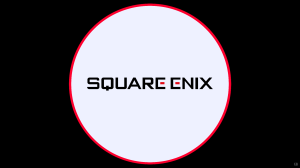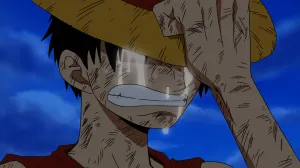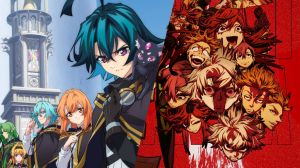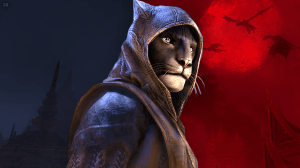This week, I attended a special preview of Disney Pixar’s The Good Dinosaur, their big release for this year’s Thanksgiving weekend. While there weren’t many extended scenes shown, this was by far and away the best look at the film I’ve had to date, and getting to see the unique blend of realistic context and more cartoon-like characters revealed just how unusual a tone this project is going for.
Videos by ComicBook.com
Indeed, there’s not real anything else quite like this film out there, just yet. There’s a way to go until the film is finished – director Peter Sohn told me they’d likely complete the film in October – but there was enough on display to give us plenty to talk about.
Here’s the full transcript of my chat with Sohn, about the film’s cutting edge look, its dangerous nature and unique story world, and that loaded title. We also talked just a bit about the unusual way in which animated films are written and re-written in storyboard form.
Why go for a photo-realistic look? What do we get from this?
We’re trying to make nature a real threat. We did tests early on where, if we made the trees a little more blocky, more graphic, it seemed to water down the dangers of the world for Arlo. This is pretty much a survival film for him, and the more we make it realistic, the more dangerous it seems.
It’s a real fine balance, in truth. The lighting of the movie has been caricatured to be slightly more dramatic than real lighting, for sure. And on top of that, the shades are very realistic. It’s all in an effort to make it seem like, when something dangerous happens, Arlo can get hurt.
Outside of the lighting, then, what else have you pulled back from reality to get the balance?
In the physics there are some sine movements that will change, and how the characters interact with the world will change, but it’s all on the grand arc of Arlo’s central storyline.
Some original information that I had said that Arlo had created the situation that led to him leaving his family, but from what we saw today, it seemed like his departure was an accident. Is it still both?
It’s both. It’s still his own doing. What happens to Arlo’s father triggers something inside him that leads to the accident of him falling into the river.
The film is called “The Good Dinosaur.” Interpret that title for me.
Arlo, when he is born, he has these issues he deals with on the farm, issues related to him not being able to help in an analogue world of farming, where you have to be strong, to be able to do these things. He becomes isolated because of his fear and weakness, and he feels unworthy of his place, but as the film goes on he strives to be better, to be The Good Son that he was hoping to be. The whole story is told under that conceit.
It can do anything or be anywhere, so what tells you that your virtual camera is in the right place?
It’s a back and forth between your gut and a need for story clarity. Learning all of the rules and tools of what a camera position can be, it’s sometimes very subjective, and sometimes it can be very black and white. You’re always trying to question “Is this the right shot? What is it telling us? What are we trying to say that is going to lead us and further the storyline?”
You always try to break things down on a shot-to-shot basis. Trying to find an angle is not an arbitrary thing, it’s always about the right emotion and the right clarity. For sure.
The writing process on an animated film is unlike the process on any other film. When you watch a new version of a scene being pitched, what are you looking for? And will give you confidence, or challenge your confidence, in what you see?
So much of it is trusting your gut. There are two sides to this. There’s the audience member in you, where you’re just taking something at face value, and then there’s the analytical side where you try to focus in on why something is either working or not working. The initial idea is always “We are building this sequence for this one main reason. Let’s try to build that and sell that.”
When you watch the pitch, you’re aware of how much it’s doing that first job, if it’s selling that idea that it originated with. If it is, then you ask “Is this the clearest way to present this?” That’s if step one was already going well. And then, on top of that, there’s always an energy in a pitch that is an unknown factor. If somebody is pitching really well they can hide facts of the sequence that you won’t see until you’ve cut the sequence up and put sounds to it, then see it in a film format on reels.
And then, after you’ve seen a scene on reels, you go through the whole process again. Is this still doing what it should now that it’s cut? Is it working as a sequence that’s supporting the rest of the film? It’s Yes or No and you start bifurcating from there, the different the decisions that have to made.
If the initial pitch is not working, if they do not sell the original idea, then you have the choice of fixing it, repairing it, or even seeing if there’s value in the new twist that’s been made. Should we go down this all-new route?
For all of these moments, it’s always about the betterment of the film and the clarity of the storytelling, for sure, but each time something is pitched, there are so many variables to make it either work or not. You depend on your initial gut feeling from the first time you see it, particularly because, in animation, you look at everything so many times, over and over again, you can easily lose objectivity. Finding what the innocent viewing can tell you can be very important, and you have to train yourself to judge that, and to capture it to help make decisions.
What sort of time span has passed between the meteor passing Earth by, not ending the reign of the dinosaurs, and the events of this narrative?
It’s millions of years, in an ambiguous way. We’re getting to the point where the dinosaurs are speaking but don’t have a great deal of technology. It’s almost like frontier living, and we’ve always had this story in that kind of world.
So they’re just on the cusp of an industrial revolution?
Sort of. We don’t allude to a lot of it, but I bet that if they kept going down their route, they’d get to that level for sure.
—-
Thanks again to Peter for taking the time to talk to me. The Good Dinosaur will be in US cinemas on November 25th and UK cinemas on Friday November 27th. I can’t wait to see the whole thing.









